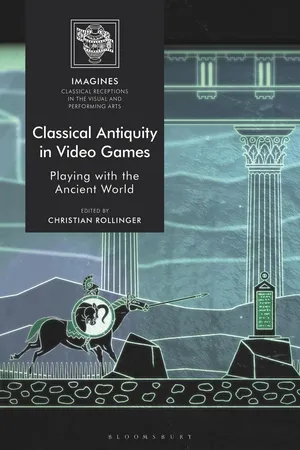
Classical Antiquity in Video Games
Playing with the Ancient World
- 312 pages
- English
- ePUB (mobile friendly)
- Available on iOS & Android
Classical Antiquity in Video Games
Playing with the Ancient World
About This Book
From gaming consoles to smartphones, video games are everywhere today, including those set in historical times and particularly in the ancient world. This volume explores the varied depictions of the ancient world in video games and demonstrates the potential challenges of games for scholars as well as the applications of game engines for educational and academic purposes. With successful series such as "Assassin's Creed" or "Civilization" selling millions of copies, video games rival even television and cinema in their role in shaping younger audiences' perceptions of the past. Yet classical scholarship, though embracing other popular media as areas of research, has so far largely ignored video games as a vehicle of classical reception. This collection of essays fills this gap with a dedicated study of receptions, remediations and representations of Classical Antiquity across all electronic gaming platforms and genres. It presents cutting-edge research in classics and classical receptions, game studies and archaeogaming, adopting different perspectives and combining papers from scholars, gamers, game developers and historical consultants. In doing so, it delivers the first state-of-the-art account of both the wide array of 'ancient' video games, as well as the challenges and rewards of this new and exciting field.
Frequently asked questions
Information
1
An Archaeology of Ancient Historical Video Games

Hardware and genre
Table of contents
- Cover
- Half-Title Page
- Series Text
- Title Page
- Contents
- List of Illustrations
- Notes on Contributors
- Preface
- Prologue: Playing with the Ancient World: An Introduction to Classical Antiquity in Video Games Christian Rollinger
- 1 An Archaeology of Ancient Historical Video Games Christian Rollinger
- Part One A Brave Old World: Re-Figurations of Ancient Cultures
- 2 Ludus (Not) Over: Video Games and the Popular Perception of Ancient Past Reshaping David Serrano Lozano
- 3 Playing in a ‘Real’ Past: Classical Action Games and Authenticity Tristan French and Andrew Gardner
- 4 The Representation of Women in Ryse: Son of Rome Sian Beavers
- Part Two A World at War: Martial Re-Presentations of the Ancient World
- 5 Battle Narratives from Ancient Historiography to Total War: Rome II Dominic Machado
- 6 Digital Legionaries: Video Game Simulations of the Face of Battle in the Roman Republic Jeremiah McCall
- Part Three Digital Epics: Role-Playing in the Ancient World
- 7 The Bethesda Style: The Open-World Role-Playing Game as Formulaic Epic Roger Travis
- 8 Postcolonial Play in Ancient World Computer Role-Playing Games Ross Clare
- 9 Playing with an Ancient Veil: Commemorative Culture and the Staging of Ancient History within the Playful Experience of the MMORPG, The Secret World Nico Nolden
- Part Four Building an Ancient World: Re-Imagining Antiquity
- 10 Choose Your Own Counterfactual: The Melian Dialogue as Text-Based Adventure Neville Morley
- 11 Mortal Immortals: Deicide of Greek Gods in Apotheon and Its Role in the Greek Mythic Storyworld Maciej Paprocki
- 12 The Complexities and Nuances of Portraying History in Age of Empires Alexander Flegler
- 13 Simulating the Ancient World: Pitfalls and Opportunities of Using Game Engines for Archaeological and Historical Research Erika Holter, Una Ulrike Schäfer and Sebastian Schwesinger
- 14 Quo Vadis Historical Game Studies and Classical Receptions? Moving Two Fields Forward Together Adam Chapman
- Glossary of Video Game Terms
- Bibliography
- Mediography
- Ludography
- Index
- Copyright